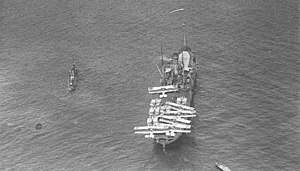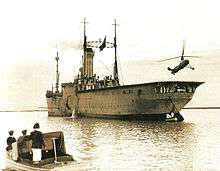Spanish seaplane carrier Dédalo
Dédalo (Spanish for Daedalus) was a Spanish seaplane and balloon carrier, the first of two ships of the Spanish Navy to bear this name. She entered in service in 1922 and was written off in 1936, after taking part in the Second Moroccan War, where her aircraft were instrumental to the successful landing of Franco-Spanish forces at Al Hoceima.
 Spanish seaplane carrier Dédalo, during the landing of Al Hoceima, September 1925 | |
| History | |
|---|---|
| Name: | Neuenfels |
| Builder: | Swan Hunter, Newcastle |
| Completed: | 1901 |
| Out of service: | Seized by Spain, October 1918 |
| Name: | Dédalo |
| Acquired: | 1921 |
| Commissioned: | 1922 |
| Decommissioned: | 1934 |
| Stricken: | April 1936 |
| Fate: | Scrapped 1940 |
| General characteristics | |
| Displacement: | 9,900 tonnes |
| Length: | 127.4 m |
| Beam: | 16.76 m |
| Draft: | 7.4 m |
| Installed power: | one 3-cylinder reciprocating engines, 1 shaft, 3,000 shp |
| Speed: | 10 kn (19 km/h) |
| Crew: | 398 |
| Armament: |
|
| Aircraft carried: | 20 seaplanes, 2 dirigibles, 2 captive balloons |
History

Dédalo was originally the German steamer Neuenfels, built in Britain in 1901. In October 1918, towards the end of World War I, she was seized along with five other German ships interned at Spanish ports at the time, as reparations for Spanish ship losses to Germany's unrestricted submarine warfare during the war. Neuenfels was given the temporary name "España No.6", until she was transferred to the Spanish Navy in the autumn of 1921. The Spanish Naval Aeronautics had been interested in acquiring a seaplane carrier for some time, and "España No.6" was accordingly renamed Dédalo, then spent five months in Barcelona from December 1921 to be converted into a seaplane tender at a cost of 8 million pesetas.

Based in Cartagena, Dédalo participated in the Rif War until 1925, with her seaplanes carrying out bombing raids in support of the amphibious landing at Al Hoceima.[1]
_(en_1922).svg.png)
After the proclamation of the Second Spanish Republic in April 1931 it became part of the Spanish Republican Navy. On 7 March 1934 aviation history was made when Juan de la Cierva, the inventor of the autogyro, performed a perfect landing onto Dédalo with a model C. 30 autogyro registered G-ACIO, near the port of Valencia; half an hour later it took off from her deck, after a short run of just 24 metres. This was the first rotorcraft to take off and land on the deck of a ship.[2]
Dédalo was decommissioned in 1934, and was struck in April 1936,[3] but the Spanish Civil War prevented her from leaving her homeport of Cartagena until 1 March 1940, when she was towed to Valencia for scrapping.
Aircraft facilities
Dédalo could carry two captive observation balloons of 1,200 m³ volume, 2 Italian-built dirigibles of 1,500 m³ volume, and up to 20 seaplanes of various types over the years, including Felixstowe F.3, Savoia S.16 and S.16 bis, Macchi M.18 and Supermarine Scarab.
Dédalo was equipped with two hangars. The one in front of the superstructure was reserved for the dirigibles, with a mooring mast at the bow. The other, behind the superstructure, was fitted with an elevator to service the seaplanes. Having neither a flush deck nor a catapult, her seaplanes had to be launched and retrieved by cranes.
See also
References
- Hemeroteca ABC: Las sufridas, Heroicas alas de España (in Spanish)
- "The first Dedalo was an aircraft transportation ship and the first in the world from which an autogyro took off and landed." Naval Ship Systems Command, US: Naval Ship Systems Command technical news.1966, v. 15-16, page 40
- Hemeroteca ABC: El portaeronaves Dédalo, ha sido dado de baja (in Spanish)
External links
| Wikimedia Commons has media related to Dédalo (ship, 1901). |